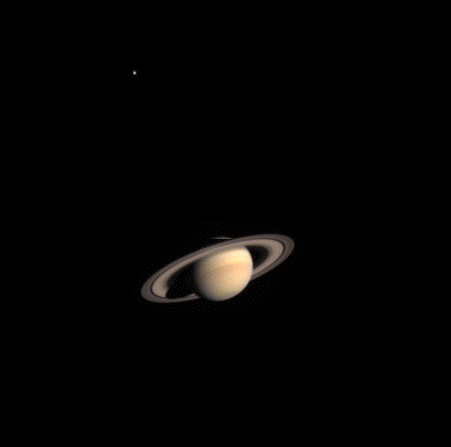Astronomy Picture of the Day
Discover the cosmos! Each day a different image or photograph of our fascinating universe is featured, along with a brief explanation written by a professional astronomer.
Posted on 11/03/2002 10:36:03 PM PST by petuniasevan
Discover the cosmos! Each day a different image or photograph of our fascinating universe is featured, along with a brief explanation written by a professional astronomer.
Explanation: Cassini, a robot spacecraft launched in 1997 by NASA, is close enough now to resolve many rings and moons of its destination planet: Saturn. The spacecraft has closed to about two Earth-Sun separations from the ringed giant. Last month, Cassini snapped several images during an engineering test. These images have been combined into the contrast-enhanced color composite pictured above. Saturn's rings and cloud-tops are visible on the far right, while Titan, its largest moon, is visible as the speck on the lower left. When arriving at Saturn in July 2004, the Cassini orbiter will begin to circle and study the Saturnian system. Several months later, a probe named Huygens will separate and attempt to land on the surface of Titan.
And theory is the easy part; ask any engineer.
I wouldn't even be surprised if many people have forgotten about the Cassini probe, or even never heard of it.
I have posted a simulated position report on Cassini below.



The ISS consists of two framing cameras. The narrow angle camera is a reflecting telescope with a focal length of 2000 mm and a field of view of 0.35 degrees. The wide angle camera is a refractor with a focal length of 200 mm and a field of view of 3.5 degrees. Each camera is outfitted with a large number of spectral filters which, taken together, span the electromagnetic spectrum from 2000 Angstroms to 1.1 microns. At the heart of each camera is a charged coupled device (CCD) detector consisting of a 1024 square array of pixels, each 12 microns on a side. The data system allows many options for data collection, including choices for on-chip summing and data compression.
The ISS instrument comprises a pair of aligned cameras, one wide angle (WAC) and one narrow angle (NAC). These are mounted on the side of the Cassini orbiter spacecraft.
The WAC actually uses an optical system that was originally built as a spare for the Voyager missions, but couples this with the hugely improved detector technology of the 1990's.
The NAC and WAC each have a pair of filter wheels in their optical path. This allows imaging in a large range of spectral bands (i.e. colours) across the wide (ultraviolet to infrared) sensitivity band of the CCD detector.
Each camera has a CCD image sensor of size 1024 x 1024 pixels. The images are digitised with 12 bit resolution.
To allow more images to be stored in the spacecraft memory and to decrease the downlink requirements it is possible to compress the images. Both lossless compression and lossy compression (using a form of JPEG) are supported. Using lossless compression, images can typically be about halved in size and then perfectly reconstructed when received - this is like using a "zip" program to compress computer files. Lossy compression allows images to be shrunk much more (typically to about 10% of their original size), but means that some of the finer detail is discarded and cannot be restored. Many of the images at this and other websites use similar JPEG lossy compression to speed them over the net: these images are fine to look at by eye, but cannot be enhanced much to look for subtle features because the information is just not there any more. By having both options, the Cassini ISS will allow both fast, plentiful imaging and slower, more detailed imaging to be done.
At QMW we investigated what effects lossy compression would have on images of faint rings.
The Voyager cameras used 8 bit digitised images from vidicon tubes.The modern cameras have a number of very significant advantages:
Disclaimer: Opinions posted on Free Republic are those of the individual posters and do not necessarily represent the opinion of Free Republic or its management. All materials posted herein are protected by copyright law and the exemption for fair use of copyrighted works.